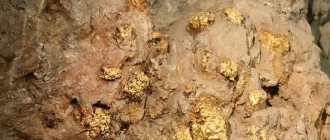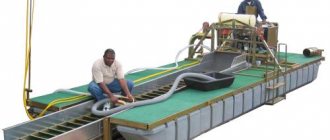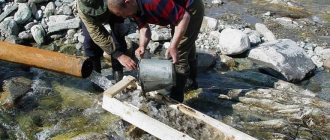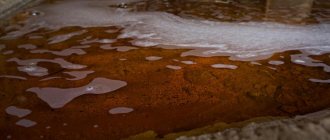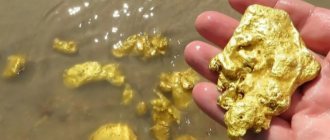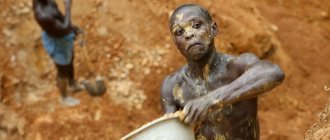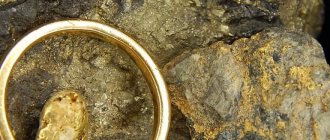Post updated: Jun 5, 2020
Almost 95% of the gold mined in Russia is extracted in 15 regions located in Siberia and the Far East. The largest share of yellow metal production comes from primary mining, but placer mining is no less important. The Russian gold mining industry is based specifically on alluvial deposits: our country is the undisputed world leader in the extraction of alluvial gold. The gold of Siberia, the bulk of which comes from the Krasnoyarsk Territory, Irkutsk Region and Altai, allows Russia to remain the leader in the production of the yellow metal.
Gold Rush in Siberia
The gold rush in Siberian lands began in the first half of the 19th century. The impetus for the mass extraction of precious metal by everyone was the decree of 1812 that all Russian citizens were given the right to search for ores of precious metals and engage in their development with the condition of paying a tax to the state budget. The extraction of the yellow metal in Siberia began with the development of territories on the Sukhoi Berikul River; wine merchants Popovs invested a lot of money in the exploration of these places.
Over the next years, gold deposits were discovered on the Mokroy Berikul and other tributaries of the Kiya River, in the Salair Ridge, in the Krasnoyarsk and Minusinsk districts of the Yenisei province. A little later, the development of gold deposits began in Western Transbaikalia. Throughout the 19th century, the development of the lands of the Yenisei province was largely due to the spread of gold mining: during these years the population increased, trade developed, and shifts in transport communications were noted.
Successful gold mining in Siberia earned the attention of foreign geologists, who began to look for territories similar in geological and geomorphological characteristics to the gold-bearing Siberian zone. As a result of research in the mid-19th century, gold was found in the American territory of California, where its own “gold rush” began.
By the end of the 19th century, the Siberian gold rush began to decline. This phenomenon was due to the fact that a huge part of the profits from gold mining was exported by industrialists and invested in shipping and trade, rather than remaining in the industry. A significant outflow of capital led to the fact that by the 20s of the last century, the extraction of solar metal from the depths of Siberia fell sharply; with the advent of Soviet power, private gold mining in these territories was completely eliminated.
Today, the largest company developing the gold reserves of Siberia is the Polyus Gold enterprise, the leader of the Russian and global precious metals markets. The company works at the most famous deposits in the Krasnoyarsk Territory and the Irkutsk Region, including almost a hundred placer deposits located in the Vitim River basin.
Real situation
In countries such as South America, Africa, Asia, a huge number of people are saved by extracting gold using the artisanal method. It is easier to mine in areas where the source of the precious metal is volcanic activity, because in this case the gold is located shallow from the surface of the earth.
It is possible to identify areas that relate to this:
- Far East (Khakanja),
- Aldan (Kuranahanskoye),
- Rudny Altai,
- Olkhovka,
- Chibizhek.
In these areas, more than 10 million people are engaged in this type of activity. Extraction is carried out manually, which saves on industrial-scale development.
That is why alluvial deposits were a priority, and indigenous ones were not popular.
There are countries where artisanal mining is prohibited, including Russia. Article 191 of the Criminal Code states that those who engage in this type of activity can be imprisoned for up to 7 years and receive a huge fine. Because of this, the percentage of unemployed in the regions of Siberia and the Far East has rapidly increased. This may have consequences – an outflow of citizens to more developed regions.
The precautions taken did not contribute to the complete disappearance of illegal immigrants. It is unknown how many of them work in various taiga mines. But there is information that the Krasnoyarsk Territory annually supplies 1-2 tons of gold mined illegally. Therefore, criminals are regularly detained. To have the right to carry out work, you need to buy a license from gold mining organizations.
There are countries where searching for valuable metal is allowed. These include America, Canada and Australia. A license for this type of activity is inexpensive, only $30. People can purchase a metal detector and calmly search for the metal of interest.
In this regard, tourism is actively developing, the purpose of which is gold mining.
Gold of the Krasnoyarsk Territory
The Krasnoyarsk Territory is a gold-bearing region of Russia with a total gold production per year of about 70% of the total Russian volume. It was the Krasnoyarsk Territory that brought 60 tons of indigenous (nugget) gold and almost 6 tons of placer gold to the Russian treasury in 2021. Geological exploration here is expanding every year, new deposits are being found and gold mining is growing.
In total, there are three main gold mining areas in the Krasnoyarsk region:
- Karatuzsky and Kuraginsky districts in the south of Siberia - there are very few gold deposits left here, the main deposits are completely worked out.
- The North Yenisei region is the main gold-bearing source in Siberia.
- Taimyr - 2-3% of its subsoil has been studied, so the potential, according to experts, can be very significant.
In general, there are 300 deposits and promising explored places in the Krasnoyarsk Territory, which contributes well to the development of the Siberian hinterland.
Metal mining in the Irkutsk region
The largest part of gold mining in the Irkutsk region is concentrated in the Bodaibo region, more than 90% of all gold mined in the region is extracted here. Over one and a half hundred years of development, 1.2 thousand tons of yellow metal were mined here. Gold mining is the leading activity in the region and accounts for more than half of all mined minerals in value terms. The Irkutsk region is the leader in alluvial gold mining in Russia; ore deposits are less developed. Experts associate the further development of the gold mining industry in the region with their development.
Until the 2000s, annual gold production in the Bodaibo region was just over 10 tons, which consisted primarily of alluvial gold. In the last two decades, production volumes have stabilized at a higher level, reaching almost 15 tons of the yellow metal. In the coming years, it is planned to significantly increase aurum production through the development of ore deposits.
One of the most famous deposits, geographically belonging specifically to the Bodaibo region, is the Sukhoi Log deposit, which is one of the most unique gold mining sites in Russia. A huge part of the reserves that make up the gold of Siberia is concentrated here.
Active work on the development of Sukhoi Log began in the 60s of the last century, when geologists examined the geochemical anomaly of the area and analyzed rock samples. Preparing the field for subsequent exploitation took many years and required large financial investments, but the costs turned out to be justified. Today, Sukhoi Log is the largest gold ore deposit not only in Russia, but also in the world. The gold mining giant can be called a national treasure of the country, capable of having a decisive influence on the volume of production of the yellow metal on a national scale.
In addition to Sukhoi Log, the following deposits are of great importance for gold mining in the Irkutsk region:
- Western, located next to Sukhoi Log and similar to it in the type of ores occurring;
- Chertovo Koryto, which belongs to the Bodaibinsky district and has an estimated reserve volume of 226 tons of metal;
- Verninskoye forms a single ore cluster with the Pervenets and Zapadnoe deposits, which is characterized by great prospects in terms of exploration of new reserves.
Siberian gold in the Irkutsk region is also represented by the Zheltuktinskaya and Verkhne-Kevaktinskaya promising sites, the Babushkin, Ostantsovy, Prodolny, Kopylovsky, Voznesensky and Khodokansky areas, as well as the Uryakh ore field.
If the favorable situation in the gold mining industry continues and taking into account the launch of the mining and processing plant in Sukhoi Log, the Irkutsk region in 10-20 years may reach metal production rates of 50 tons annually, displacing the Krasnoyarsk Territory from the first place in the ranking of gold mining regions.
Altai Gold
Gold mining in Altai dates back to the 18th and 19th centuries, when in these places it was smelted along with silver for the royal treasury. With the advent of Soviet power, the mining of gold reserves here practically ceased and appeared only fragmentarily, despite the great potential of ore deposits of non-ferrous metals. The southwestern territories that remained part of Russia after the collapse of the USSR are rich not only in gold, silver and copper, but also in rare and trace elements, the extraction of which in the future can bring significant economic benefits.
Alluvial gold mining resumed in Altai in the 80s, when artisanal teams took over the business, but was characterized by small volumes. By 1995, it was possible to reach only 135 kg. It took about another ten years to resume industrial ore mining. Today, thanks to the introduction of modern production in the Rubtsovsky district and the opening of several mines, including the Korbolikhinsky deposit, Altai is regaining its lost position in the gold mining industry. The development of the situation contributes to the development of untouched deposits of polymetallic ores.
Map of mineral deposits in Altai.
Almost all mineral deposits are concentrated in the southern and eastern territories of the region. Gold reserves belong to the North Altai gold belt and include several metallogenic zones. Today, deposits of placer gold, polymetals, groundwater and building materials are being developed in Altai. The development of primary deposits of the yellow metal remains a promising direction.
Alluvial gold mining in the Altai Territory yields only a few tens of kilograms of solar metal; increasing volumes is only possible through the development of ore deposits. One of the priority locations for work remains the Topolinsky ore field, which has an area of 96 square kilometers and is characterized by predicted gold reserves of 50 tons.
Experts inextricably link the future of gold mining in Altai with the search and development of ore deposits, the development of which will increase the volume of extracted precious metal to 1.5 tons per year.
Legalization
In Russia they want to legalize gold mining, because then illegal immigrants will cease to exist. Industrial mining is no longer possible in many areas, which is another reason to legalize this area of activity.
Nicholas II was loyal to gold miners - in 1902 he allowed this activity to be carried out freely. Stalin did not change anything in this order of things, which was a significant plus for the economy of the entire Soviet Union. The government provided good conditions for the activities of workers and even organized holidays for them in sanatoriums and resorts.
But not everyone could do this: those who had ever been prosecuted could not obtain permission to carry out this type of activity.
As a result, 120 thousand people became miners, they sold gold to special cash desks. Thanks to them, many deposits were discovered, which were subsequently monopolized by state-owned enterprises. Therefore, from 1932 to 1941 the volume of production increased significantly (5 times).
A ban on mining was introduced already in 1950.
Investments in gold deposits of Siberia
In recent years, investment in the gold mining industry of the Siberian Federal District has increased significantly. Along with the regions that are leaders in the production of the yellow metal, areas located in Altai and Kuzbass are of interest to investors. During the summer of 2015, local government bodies in charge of subsoil use issues held more than 10 auctions for the purchase of rights to use mineral-rich areas.
The largest part of these areas is located in Kuzbass. The reserves of the precious metal in this region are incomparable to the deposits of coal, which is called “black gold” here. Gold mining is promising in Kuzbass. According to geologists, up to 500 tons of yellow metal are stored in the Kuzbass lands, but this estimate remains unconfirmed.
Today, alluvial gold is mined using dredges running along river bottoms. Metal is extracted in this way in areas near Spassk and on Usa. The new alluvial areas that were transferred to the distributed fund have reserves of almost 800 kg, the predicted resources are characterized by a figure twice as large.
Three more sites are currently undergoing preparation for bidding. Work on two of them is complicated by the fact that in addition to gold they contain huge reserves of coal, and the third is rich not only in placer gold, but also in ore. The forecast volumes of ore in this territory are estimated by experts at 12 tons of metal. The development of these new areas will be carried out by the company that wins the auction in the fall of 2015.
Interest in Kuzbass gold is growing every year. To date, one and a half hundred gold deposits have been discovered here, most of which are of the alluvial type. Both local companies and mining giants from neighboring regions are paying attention to the development of both placer and ore deposits. Enterprises of the Krasnoyarsk Territory and Irkutsk Region are seriously interested in gold deposits in Kuzbass, the extraction of which already produces more than a ton of the yellow metal annually.
Gold from Siberia forms the basis of the gold mining industry in Russia. The region has high potential for increasing production volumes both through work on already explored known deposits in the Krasnoyarsk Territory and Irkutsk Region, and through the search and development of ore deposits in Altai and Kuzbass. The Altai and Kuzbass lands, rich in gold and other important minerals, are of the greatest interest to investors in anticipation of future income, since geological exploration confirms the presence of gold, coal, and rare base metals here.
Methods
Gold can be mined in several ways: sand washing, metal extraction in mines. At the moment, artisanal gold mining is popular. This means that the chosen places are already known, and gold was mined in them on an industrial scale, and the seekers are collecting the remains. This is labor-intensive and difficult work.
Manual panning for gold is one of the most ancient and popular methods of gold mining. During the rains, gold falls into the river; it is during such periods that miners tend to work.
A more complex method is digging. First, the metal must be dug out and then washed. Unnecessary components are crushed, washed again, and then the gold particles are independently selected.
After the desired metal has been obtained, it must be extracted from the ore. There are several ways in which this can be done.
An interesting method is mercury amalgamation. In this case, sand is amalgaated in the presence of gold particles having a size of no more than 1 mm. It is necessary to dissolve the resulting metal in a substance (mercury), as a result of which an amalgam is formed. Next, you need to strain the substance through a fine-mesh cloth. Half of the substance is gold. To obtain it, you need to evaporate the mercury.
Cyanidation and flotation involve three stages of action:
- leaching,
- concentration,
- cleaning
Cyanide and oxygen promote the leaching process. The concentrate of heavy minerals is removed through activated carbon, filtration and calcination. There is a disadvantage to this method - a high level of danger. It is caused by cyanide vapors.
Chlorination occurs using hydrochloric acid and chlorine. They can dissolve gold. The next step is to rid the metal of heavy minerals and form an ingot.
All these methods have a negative impact on the environment, because there is waste that needs to be disposed of.
